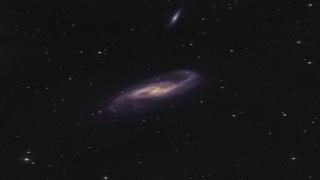Bibcode
Elvis, M.; Hao, H.; Civano, F.; Brusa, M.; Salvato, M.; Bongiorno, A.; Capak, P.; Zamorani, G.; Comastri, A.; Jahnke, K.; Lusso, E.; Mainieri, V.; Trump, J. R.; Ho, L. C.; Aussel, H.; Cappelluti, N.; Cisternas, M.; Frayer, D.; Gilli, R.; Hasinger, G.; Huchra, J. P.; Impey, C. D.; Koekemoer, A. M.; Lanzuisi, G.; Le Floc'h, E.; Lilly, S. J.; Liu, Y.; McCarthy, P.; McCracken, H. J.; Merloni, A.; Roeser, H.-J.; Sanders, D. B.; Sargent, M.; Scoville, N.; Schinnerer, E.; Schiminovich, D.; Silverman, J.; Taniguchi, Y.; Vignali, C.; Urry, C. M.; Zamojski, M. A.; Zatloukal, M.
Referencia bibliográfica
The Astrophysical Journal, Volume 759, Issue 1, article id. 6, 20pp, (2012).
Fecha de publicación:
11
2012
Revista
Número de citas
71
Número de citas referidas
68
Descripción
The "Cosmic Evolution Survey" (COSMOS) enables the study of the spectral
energy distributions (SEDs) of active galactic nuclei (AGNs) because of
the deep coverage and rich sampling of frequencies from X-ray to radio.
Here we present an SED catalog of 413 X-ray (XMM-Newton)-selected type 1
(emission line FWHM > 2000 km s–1) AGNs with
Magellan, SDSS, or VLT spectrum. The SEDs are corrected for Galactic
extinction, broad emission line contributions, constrained variability,
and host galaxy contribution. We present the mean SED and the dispersion
SEDs after the above corrections in the rest-frame 1.4 GHz to 40 keV,
and show examples of the variety of SEDs encountered. In the
near-infrared to optical (rest frame ~8 μm-4000 Å), the
photometry is complete for the whole sample and the mean SED is derived
from detections only. Reddening and host galaxy contamination could
account for a large fraction of the observed SED variety. The SEDs are
all available online.
Proyectos relacionados

Las Galaxias Espirales: Evolución y Consecuencias
Nuestro grupo pequeño esta bien conocido y respetado internacionalmente por nuestro trabajo inovativo e importante en varios aspectos de la estructura y la evolución de las galaxias espirales cercanas. Usamos principalmente observaciones en varias longitudes de onda, explotando las sinergías que nos permiten responder a las cuestiones más
Johan Hendrik
Knapen Koelstra